Friedens Church
The Friedens congregation ran from 1869-1986 (117 years). It was always at the same location: 13th & Juneau in Milwaukee. The church building at 1234 (1244) W. Juneau Ave. was built in 1905. It is over 100 years old!


The Friedens congregation ran from 1869-1986 (117 years). It was always at the same location: 13th & Juneau in Milwaukee. The church building at 1234 (1244) W. Juneau Ave. was built in 1905. It is over 100 years old!

The Friedens Evangelical & Reformed United Church of Christ at 13th & Juneau in Milwaukee, Wisconsin, was built in 1905. The United Church of Christ (UCC) is the eighth largest religious denomination in the United States. The UCC is comprised of three denominations that merged prior to 1960: Evangelical, Reformed, and Congregational. The Friedens congregation was started in 1869 by an Evangelical missionary from Germany. The Evangelical denomination began in 1817 when the King of Prussia (northern Germany) merged the Lutheran and Reformed denominations there. (Note: The Evangelical Association and Evangelical Lutheran denominations did not become part of the UCC.)
The first Friedens church was wooden and stood in the same place. It was moved several miles away to make room for the 1905 brick church, whose address is 1234 (formerly, 1244) W. Juneau Avenue. The church property is on the site of a German Protestant cemetery that closed before 1870. Some, but not all, remains were moved to other cemeteries. When excavation is done along 13th St., bones are still found. Workers laying pipes a few years ago uncovered some remains, and then put them back in place after the pipes were laid. The above photo was taken in 1980 (photographer unknown).
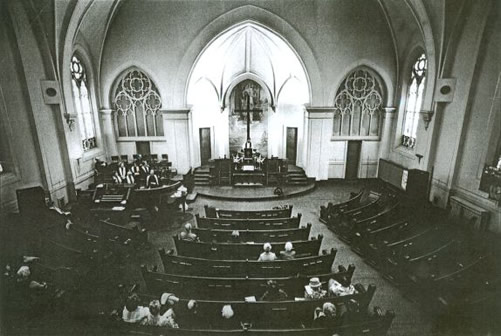
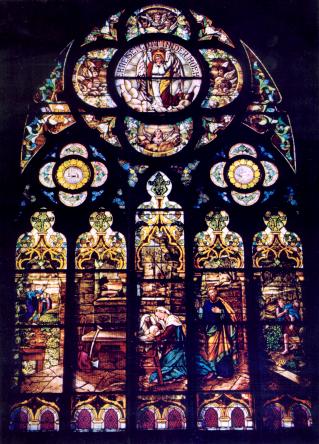

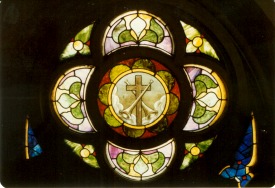
Friedens' art glass windows are said to have come from Germany. Above is the Christmas window, 27 feet high and 17 feet wide. The Easter window is the same size; the Sermon on the Mount window is only slightly smaller. There are six other windows that are two stories tall, and many smaller windows of various shapes and sizes. Some are seen at every turn of the two stairways to the balcony. One stairway is in each tower. The "towers" are the areas under each steeple. Friedens is an architectural fun house. This photo was taken about 1980 (photographer unknown).
These two smaller photos (above) taken about 1986 by then-Friedens-members Paul & Maris Fried show the tops of two windows along the west side of the balcony. These windows are 5 feet wide. The windows in the church vary in theme from narrative scenes to symbols and floral designs, but they all seem like part of a whole, as though all were made by the same company.
Friedens Church was a great asset to the City of Milwaukee during its 117 years (1869-1986). Long ago, Friedens was a major founder of Deaconess Hospital. It operated a food and clothing pantry during the Great Depression. In better times, it was known for its Sunday school picnics, musicals, and sauerkraut suppers that drew fans of German cuisine from all over the city.
By the early 1960s, Friedens was mainly a commuter church with members living in every Milwaukee zip code, and some beyond. As urban problems / social unrest in America grew, the UCC denomination became one of the groups heavily involved in social justice issues. Friedens had always tended its neighborhood and not just its members, but in the 1960s, 1970s, and 1980s, Friedens became a center for activism. Many community service programs were started by, or based at, Friedens. Remarkably, three of them continue today, under other auspices: the Friedens Food Pantry (at another location), the Guest House Homeless Shelter (in the old Friedens Sunday School and Fellowship Hall), and Elder Care (now, Transit-Plus).
This outreach was all the more remarkable because of the relatively small size and modest means of the congregation. What Friedens had was good ideas, excellent leadership, optimism, compassion, and stoicism, which is perhaps the most important type of courage. In that regard, Friedens represented some of the best things about Milwaukee, and Wisconsin.
Those were not easy times. Friedens lost members who could not tolerate the break-ins, and the purse snatchings on Sunday mornings. Those who remained saw history being made, or even had a hand in it. Members volunteered to drive for Elder Care or staff the pantry or shelter. They served food at the St. Ben's meal program. Friedens loaned the use of its buildings to Green Trees, Inc., the (black) community self-help group. Though Friedens' own assets were dwindling in the 1980s, it lent money to neighbors to rehab their homes. With so few members and so little money, Friedens was forced to disband in 1986. It no longer exists -- except in our hearts.We like to think that Friedens, in its own small corner of the world, made a difference.
For 58 years out of its history, Friedens was led by two, long-term pastors who were also community leaders. Rev. William Schlinkmann, who was from St. Louis, was Friedens' pastor for 40 years from 1919-1959. He was on the board of directors of Deaconess Hospital, and was active in civic affairs. He never drew a large salary, and he once asked that part of his salary go toward a raise for the church janitor. He was known for his kindness, and his spellbinding oratory packed the church.
Rev. Herbert Huebschmann came from Buffalo, New York, in 1960, and was active in social justice issues. He marched with Father Groppi for open housing in Milwaukee, and marched in Selma for civil rights. He overexerted himself with all of his hands-on activities, and died from a heart attack at age 51. Empty seats were hard to find at his memorial service at Friedens in April 1978. Many local dignitaries attended.
Dr. Schlinkmann always answered the door wearing a suit. Rev. Huebschmann wore a beard and rode a motorcycle. As different as they were, both of them inspired people, and helped make Milwaukee a better place. Great people are not found only elsewhere. We have always had them here, too -- in Milwaukee.
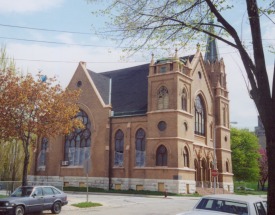
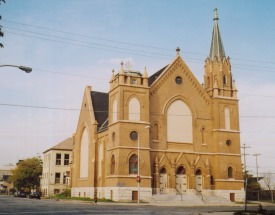
"Friedens" church continues to be a landmark in its neighborhood at the northwestern corner of downtown. The church is just two blocks from the Pabst Brewery complex, which is being redeveloped. The neighborhood has improved. In the last 10 or 15 years, many houses were torn down around 13th & Juneau, and the ones that remain are in good shape or suitable for rehabilitation.
In February, 2002, the church suffered a basement fire that did relatively minor damage to the basement and part of the first floor. However, firemen broke the lower third of many of the large windows when the building got too hot inside for their safety. It was a hot fire because an accelerant, a can of paint thinner was involved. In the photo at left, above, the broken areas are covered with clear plastic. In January 2003, many windows, even some that were not broken, were covered with vinyl siding.
In 1983, Friedens Church had its taller steeple removed after a small amount of masonry fell from it. Its largest bell was removed; the other bells and the chimes remain. Some bricks have been missing from the top of the east gable (not visible in these photos) since 1985.
After Friedens disbanded in 1986, the church building was sold to Soul's Harbor Baptist Church, which came to Milwaukee from Brookfield, Wis. Soul's Harbor owned the building until 1990. It didn't move far: It built a small church across the alley, on 12th Street. There, it helps the downtrodden and operates a Christian day school.
Since 1990, "Friedens" church has been owned and/or occupied by Free Spirit Missionary Baptist Church although you could have called it the "mystery church." For about 15 years, there was never a sign on the building announcing the congregation's name. In May 2005, a sign finally appeared with the name of the congregation and pastor. It lists two hours per month when a food and clothing pantry is open, but still does not include a schedule of religious services.
In October, 2004, news came that the church had been listed as for sale for over a full year. In spring of 2005, there was talk of another congregation being interested in buying the church and also a house nearby on 13th St. The house is between Highland and Juneau on the east side of 13th St. It is the house with wraparound porches.
(The above photo essay on Friedens Church was added October 20, 2003; revised 10-21 & 10-23-03 and July 8 & 11, 2005. Latest Updates: October 7, 2004, and July 8, 11, 13, 15, and 19, and August 1 and November 12, 2005.)